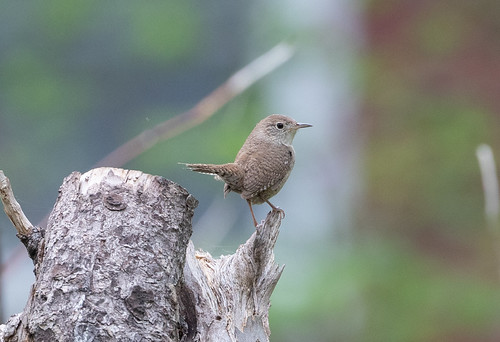House Wrens nest in my neighborhood every year. My neighbor Jeanne has a wren house that is always a happenin’ place—I’ve taken photos of her birds several times in past years. I know they’ve nested in our brush pile, and in a wren house I have in the back of the yard, but I never seem to be in the right place at the right time on the day the babies fledge.
I was hoping this year would be different, with me hunkered down at home all summer, but no luck at all in May, June, or July, even as I paid close attention. Indeed, I got hours of wonderful House Wren song recordings starting on May 7, when I heard my first on Peabody Street, and House Wrens became the dominant singers of my dawn chorus recordings throughout June and the first half of July. (You can hear a half hour of one wren singing here.) It’s been thrilling getting such beautiful recordings of these birds—I’ve gotten some photos, too, but haven’t tried very hard because it’s easy to distract and disturb a male, stopping him from singing, and nice recordings seemed much more urgent than photos.
Then Tuesday, August 4, I went out and heard lots of chips and scolding in the back of my yard, and voila! I wasn’t very skilled at first at finding the tiny fledglings perched in Russ’s raspberry patch and in the dense dogwood, daylilies, and other thick vegetation, but by afternoon, when I’d mastered distinguishing the single and double chips of the fledglings from the scolding of the parents, I could see 6 fledglings and heard at least one more, and more likely two, at the same time! House Wren broods start out with anywhere from 3 to 10 young, so 7 or 8 fledglings is excellent but hardly unheard of. I was absolutely thrilled.
By afternoon, I wasn’t the only one paying attention to them—my Blue Jay parents were apparently hoping to capitalize on the confused wren babies, whose first flights were clumsy and short, and their steady chipping when hungry seemed as useful to Blue Jays looking for protein as for House Wren parents wanting to feed their scattered young.
On Wednesday morning, I could hear baby wrens at first light, and was relieved that a lot of them made it. But now I watched the two adult Blue Jays—distinguishable from their gorgeous young now because the adults are molting, looking very scruffy—taking turns sitting on the roof of my neighbor’s shed while scanning the raspberry bed. I watched one drop into the raspberries and come up with a little brown puffball. That was all that I had the stomach for. As I walked into the house, I could hear the baby jays calling and begging next door on the other side when that parent flew in. And I could hear one hungry jay stop whining suddenly to eat its breakfast.
I’ve always known how difficult life is for birds, and why wrens and some other species have such large broods two and even three times a year, yet their populations stay the same. But I managed for 68 years to not think very hard about how exceptionally fraught the first day or two out of the nest are for tiny fledglings. I love Blue Jays, and I love House Wrens. I’m thrilled that I got photos of my baby wrens yesterday, and I know I’m not the one who alerted the jays to them—the baby wrens did that themselves. And the jays weren’t around when I was out there yesterday.
Now the jays may be persistent—they have four or five hungry fledglings themselves—but they probably won’t be able to get all of the wren babies. At least one or two may make it off Peabody Street and onto their journey south. I’ll keep listening, but now the feeling of reassurance when I hear a baby chipping will be tinged with dread, hoping a jay isn’t listening. I’m starting to understand the truth of the line, “Ignorance is bliss.”




